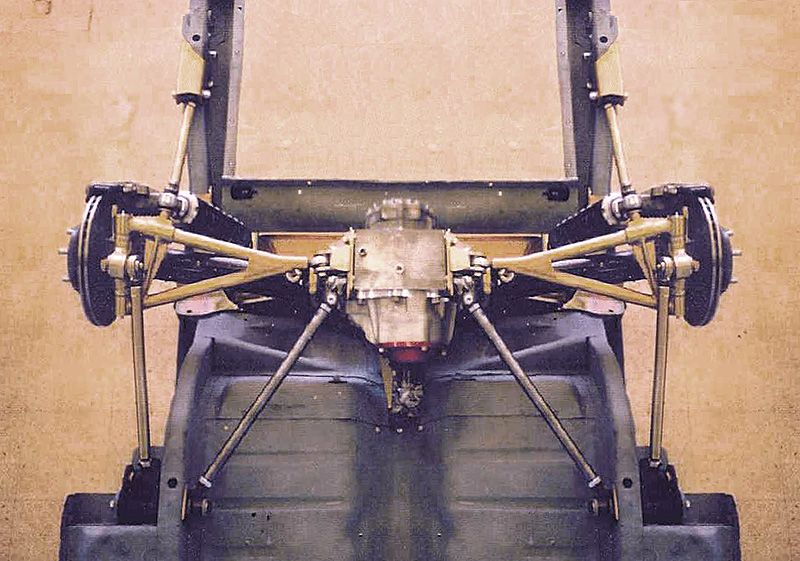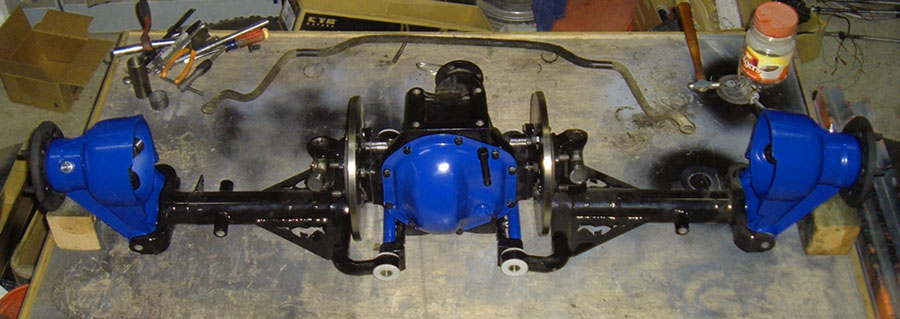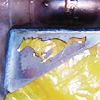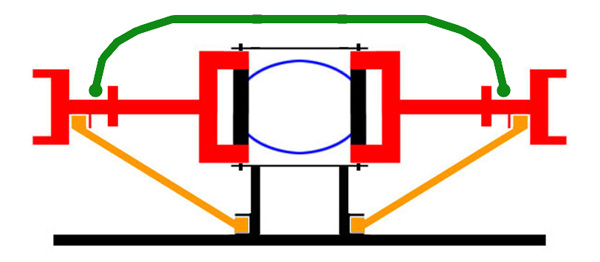

 |
 |
 |
 |
 |
You are not logged in. Would you like to login?
 1 of 1
1 of 1
![]() Offline
Offline
This is a 5000 Lbs car with a rear track of 61.5 inches. The parts come from a 1987 Jaguar XJ6
I have NEVER done a rear end of any kind so it is rear easy to get over my head. I am not really looking for better performance or looks than the Jag offered, I was looking for a solid cool unit. I was going tp set this up in the jag cage, but the thought of replacing the mounts every few years and having to drop the unit for normal service items seems a bit of a pain. So I read some on taking it out the cage and mounting like ( I have a link here that will not show)
-That brought me to the question of trailing arms and WOW do people like to argue about that ...
( I have a link here that will not show)
Anyway, I am looking for the nonflashy soultion that last- I fear poor handling forever because I tried to do too much. If you can hold my hand and make it all better cool - if I am better off ($, time, ect.) with a 9in Ford let me know... The front will be Jag
I know how to do NOTHING other what I have told you, assume comeplete dumb-dumb
Shock angle?
How To Set Pinion Angle?
How to get Ride height ?
Trailing Arm? Yes ? No
Where to buy all this stuff
What to check as I take it apart
THANKS FOR ALL HELP!
Charles Major
TEXAS
![]() Offline
Offline

First of all welcome to the forum!!!! before I address all the stuff you had questions about, I have a couple of questions of my own. first can you post the link you mentioned? Second what are your plans for the car. Daily driver, track car, or ??? Third what kind of room do you have to work with under the car??

![]() Offline
Offline
Daily driver - Why I dont mind the Jag 2.88- Sorry I may be way to square to be on this list
2003 LS1 Engine
The list will not let you post links the first 2 posts
![]() Offline
Offline


![]() Offline
Offline


It is a unibody (slash rust bucket)
![]() Offline
Offline
Cool project. Really cool project.
Personally, and I'm the outlier on this list I'm sure, if I were doing that swap I'd be retaining the Jag cage and mountings exactly as they came out of the XJ6 if at all possible. Suits the character of the car, minimizes installation hassles. Get the axle shafts horizontal with the arms sloped down toward the hub carriers.
Those cage mounts will go 60K miles anyway, and there's dozens of Nissan, BMW, Audi models for which that would be considered a normal service life for a suspension bushing.
How effing much does that thing weigh, anyway? Really only 5000lb? Those parts-book diagrams of the rear springs look like something off a 3/4-ton Suburban. Are they really a symmetrical half-elliptic (that is, front half and rear half same length?) There's a rod project I've got in mind that's going to need something very much like that...
I'm sure you'll get chapter and verse on pinion angle, with a 2.88 gear you can probably get away with a one-piece 3.5in+ aluminum driveshaft without hitting critical-speed issues even as long as you'll need for that car (126in wheelbase/) but I'd run a two-piece shaft with a center bearing anyway. I'm a big, big believer in looking around at what various OEs do for solutions, and if you look at two-piece driveshaft configurations you'll find all kinds of stuff. Most BMWs run a rubber flex-disc (guibo) at the transmission output, later ones have a single Cardan in the middle and a CV at the diff. Jag X308s ran a guibo at the diff with (I think) a pair of Cardans forward. Mercs and late Merc-derived Chryslers do something similar, IIRC. I've got an '08 GT500 shaft that's got a Cardan at the front and CVs middle and rear, but it is a stick-axle; I'm planning on using the diff-end CV at least on my MN12 IRS-converted '64 Galaxie wagon. Once again, in your case absent a reason to do otherwise I'd use the stock Jag configuration all the way back, which I think was three single Cardans running at minimal angles.
Are you really sure you want a 2.88 gear? What are you running for a transmission? 4L60E? I suspect that after a little while of hauling around all that hot-rolled East Bloc steel you're gonna wish you had 3.31s at least.
Just - and I'd do this for any Jag IRS swap - make sure your exhaust has flanges or V-band joints in it to allow for dropping the cage easily. You'll need it for brake service eventually. I'm told (never having done one myself) that dropping the cage is not that big a job.
Last edited by JEM (11/14/2011 11:55 pm)
![]() Offline
Offline
Thanks- That photo is NOT my car as my is in many small parts right now
Yes, I did want it easy and I know "custom" means 7 times as much money and 20 times the trouble, but that is not what I have been hearing with mounts like - easy to locate- easy to do service in the years to come- that is what started this thought
The springs are way overkill! this is why I could just slap a 9in on that puppy (People with good leads on 9in contact me, as that may be a dirtty word here).
The ZIM came with a 2 part shaft that was encloced and pretty cool I will try to recreate that set up
Are you really sure you want a 2.88 gear?
You may be right with the gears- where to get gear sets or pumpkins?
Last edited by charlesmajor (11/15/2011 7:19 am)
![]() Offline
Offline
charlesmajor wrote:
Yes, I did want it easy and I know "custom" means 7 times as much money and 20 times the trouble, but that is not what I have been hearing with mounts like - easy to locate- easy to do service in the years to come- that is what started this thought
The hot-rod types do a number of things to 'clean up' the look:
a) Toss the cage and solid-mount the diff
b) Toss the trailing arms
c) Run the lower arms horizontal
the merits of which IMO are questionable.
In the stock arrangement the trailing arms take the bulk of the acceleration and braking force, the cage mounts handle cornering forces. The various mounts are widely distributed around the rear structure of the car - the cage acts as a two-foot lever either side of the diff to resist cornering forces passed through the axles and lower arms.
With the crossmember you linked it appears that they rubber-mount the diff to the crossmember. If that's so, unless they've got a big something-else helping it that I'm not seeing, then the cornering forces will be rocking the diff on the crossmember and you'll get very poor camber control - even more so in a 5000lb Kremlin Kart than in a 2800lb '31 A roadster. GM went through this IIRC with the C2/C3 'Vette (and the '65 Corvair) and is the reason the C4 got the big 'batwing' on the diff cover (which replicates the functionality of the Jag cage.) What they really needed to do was solid-mount the diff to the crossmember then rubber-mount the ends of the crossmember to the frame, though in most rod frames that'd mean you'd need a second, structural crossmember to tie the frame rails together. (A big C-channel crossmember, with the C opening downward, welded to the frame with the diff hard-mounted to a narrower crossmember mounted up inside the C-channel with rubber mounts at each end...could be a product there...)
Solid-mounting ends up passing more gear noise and suspension harshness into the car, the Jag suspension has pretty much no rubber in it outside the cage and trailing arm mounts. IMO a very bad thing on a unibody car.
Always easier to tell someone else what to do, so take it for what it's worth, but if I were in your shoes I'd be trying to use the stock cage but probably with the late XJS/XJ40 outboard brakes. Read the part of the article I linked earlier about unsprung weight vs mass-damping/resonant frequency of the body structure.
charlesmajor wrote:
The springs are way overkill! this is why I could just slap a 9in on that puppy (People with good leads on 9in contact me, as that may be a dirtty word here).
Well, I've got the 9in that came off the '64 wagon, though shipping probably makes it uneconomical and it's got the relatively weak tapered 28-spline axles, I think you might be better off just finding a junkyard with a decent selection of F150s if you decide to go that way.
Last edited by JEM (11/15/2011 10:23 am)
![]() Offline
Offline

charlesmajor wrote:
Daily driver - Why I don't mind the Jag 2.88- Sorry I may be way to square to be on this list
2003 LS1 Engine
Square, round, triangular, as long as you are interested in IRS you are welcome here!!!
now that I have a better idea where you are coming from
charlesmajor wrote:
Shock angle?
How To Set Pinion Angle?
How to get Ride height ?
Trailing Arm? Yes ? No
Where to buy all this stuff
What to check as I take it apart
I agree with JEM to a point. for your application I would use the cage. Biggest reason being that you do not need to modify the IRS to get the correct track width. In fact when I put the IRS in my 62 Galaxie I am going to use the cage for that very reason. the Galaxie is almost the identical track witch and mounting the cage makes things so much easier. the reason I say "to a point" is I would do a couple of things differently from Jag . Covered further down in this post.
I would run the shock angle the exact same way Jaguar did. For your application the stock configuration should be the best option and if you run the cage the angle is already built in. With that said you will probably need to upgrade to stiffer springs. The Jag units are a bit soft for a 4000 Jag and I fear they would be all together to soft for a 5000# car
Before you can deal with pinion angle you need to decide what exactly you are going to do. If you cage mount it you have less options to change the pinion angle, but still easily doable. Also what is the current down angle of the transmission?? that is something that needs to be looked at BEFORE the IRS is installed.
When I set my ride height I did it based on the live axle I took out of the car. I took tones of measurements before I removed the OEM unit. Basically if you set it up the way Jag intended you want the wishbones or LCAs parallel with the ground at ride height. This is how every Jaguar I have stuck my head under has been and how Jaguar intended it to be. With that said locating the Jag differential in the same basic location as your OEM differential will give you the correct ride height (assuming the OEM unit was correct, and assuming you get the correct coil springs.)
I would not ditch the trailing arms. they are an important part of the set up. If you chose to run them forward (perpendicular to the LCAs) as Jaguar did also make sure you use large rubber bushings as Jaguar did. If you want something a little more rigidly mounted than make the front mount in line with the wish bone pivots so that the two parts are moving in the same arch.
what stuff are you looking to buy???
When you pull the unit apart look for major damage in the hubs and LCAs. Both should be find but never hurts to check. bearing, u-joints and such should be replaced and the differential it self may need to be gone through.
charlesmajor wrote:
(People with good leads on 9in contact me, as that may be a dirtty word here).
You may be right with the gears- where to get gear sets or pumpkins?
Just because this is an IRS forum doesn't mean it has to be all IRS all the time. If some one has a lead on a 9" they are more than welcome to post it here. I run a fairly loose forum. the only things I "moderate" on this forum are language and that people treat each other with respect.
As to upgrading the gears. if you want to go Jaguar than contact David @ www.everydayXJ.com if you want more options upgrade to Dana 44 and check out two of my personal web pages:
JEM wrote:
The hot-rod types do a number of things to 'clean up' the look:
c) Run the lower arms horizontal
JEM that is how JAguar set it up and how it is should to be done. On all of these Jags if you look at the rear end installed in the car at normal ride height the wishbone is always horizontal. That is why (according to the Jag shop manual) when you set the camber you do it by locking the LCA in place with the LCAs parallel to the ground and then set it to 0º they want the camber at 0º at normal ride height to avoid tire scrubbing but still maximize handling. It has been my experience that a lot of hot rod guys do not do this as they want the differential tucked up in the frame.
JEM wrote:
Always easier to tell someone else what to do, so take it for what it's worth, but if I were in your shoes I'd be trying to use the stock cage but probably with the late XJS/XJ40 outboard brakes. Read the part of the article I linked earlier about unsprung weight vs mass-damping/resonant frequency of the body structure.
I am in 100% agreement Like I said above that is exactly what I am going to be doing on my 62 Galaxie even like JEM said I am going to the outboard discs for that project. The only change I would make to the stock configuration is I would come up with a custom cage mount rather than trying to utilize the Jag design AND I would run the trailing arms at an angle instead of forward perpendicular to the wish bones.

![]() Offline
Offline
Again guys I know NOTHING about suspension...
The stiffer springs sound good does anybody sell these?
Should I be using different shocks than stock? -Suggestions good here...
What is going to happen with 29 in tires? Is that going to be a problem? (Jag has 24)
Do I need the biggest sway bar they make? (more weight, taller)
![]() Offline
Offline

charlesmajor wrote:
Again guys I know NOTHING about suspension...
The stiffer springs sound good does anybody sell these?
Should I be using different shocks than stock? -Suggestions good here...
What is going to happen with 29 in tires? Is that going to be a problem? (Jag has 24)
Do I need the biggest sway bar they make? (more weight, taller)
First of all don't worry about "not knowing anything" that is what we are here for so feel free to ask any and all questions that come to mind weather they be simple or complicated. We all had to learn this stuff some where and we are all still learning, so ask ask ask. think of it this way you are the voice for all those people reading this forum who have these questions but are afraid to ask.
On to your questions:
First of all the shocks and springs are a coil-over configuration so think of them as one unit designed to work together. With that said you have to figure out what you want in a shock and then figure out the coils out from there. The OEM Jag shocks are fine and KYB also makes a performance shock for the Jag so those are all options. If using OEM or KYB shocks spring choices are limited. there are also aftermarket coil overs but they go up in price quite a bit the advantage is tons of spring choices and adjustability. At this point I would start by getting the OEM set up in and mocked up and see how the OEM coil overs handle the weight of the car. from there you can make the changes you need to make to get things dialed in
Tires shouldn't be an issue if you set the IRS with the OEM ride height and the rims fit before they should fit with the IRS
As to the sway bar the OEM Jag set up did not come with one on the XJ6 you only see them on the XJ12 XKE and other performance type cars. So I would start with out it for your application and add it later if need be.
So how are your fabrication skills??
Also have you taken the time to read my personal web pages on IRS there is a lot of reading there and not all of it will apply to your application but it will give you a good foundation in what is involved in installing an IRS. (don't take the suggestion to read my pages as me not wanting to answer your questions, we are happy to do it, just thought it might help you get more comfortable with IRS)

![]() Offline
Offline
I have a set of stock and a set of KYBs, the springs are sold apart from the shocks or as a set (which is cheaper).
I take from this thread that rear sway bars and thicker fronts may be a good idea as the spring will be overcome by the weight.
![]() Offline
Offline

the parts can be gotten as separate pieces but also as units. The together units may be cheeper but to the best of my knowledge all the "together" sets are for OEM application so I do not think you will get the spring rate you will need.
You always want your front sway bar to be thicker than the rear. On my Mustang it came with a 5/8" sway bar on the front from the factory. I replaced it with a 1" bar and then used the 5/8" bar from the front for the rear. The function of a sway bar is to level the car out or at lease reduce the tipping of the car when cornering (both centrifugal force and weight shift due to the turned tires). Most cars are about 60/40 front weight to rear weight and so the same is true of sway bars you want there thickness to be about the same ratio. in my case I have 61/39... close enough for me ![]() Also because of the shift in the front when you turn the wheels you need more sway bar there as well.
Also because of the shift in the front when you turn the wheels you need more sway bar there as well.

![]() Offline
Offline
Generally right about front/rear roll stiffness but diameter as a relative sway bar metric only works if the bars are otherwise dimensionally similar and mounted similarly.
60/40 is pretty sucky weight distribution, almost FWD territory. That's '03-04 Mustang Cobra territory, which is bad. The iron-block S197 GT500 was 59/41, before they went to the aluminum block last year.
55/45 is more typical of an older nose-heavy ponycar. His Brezhnev Buick is probably closer to 53/47.
Supposedly my wagon in stock form was something like 47/53. Big rear quarter glass, heavy tailgate, lots of heavy stamped-and-welded load floor pieces.
Last edited by JEM (11/16/2011 12:46 am)
![]() Offline
Offline

JEM wrote:
Generally right about front/rear roll stiffness but diameter as a relative sway bar metric only works if the bars are otherwise dimensionally similar and mounted similarly.
That is why I am so thrilled that I was able to make the OEM front sway bar from my Mustang fir on the rear. It is the exact same shape, will be mounted the same why and should provide the same reactions as the front only less. I recently upgraded the front sway bar in my Galaxie (made a huge difference in handling!!!) any way I am hanging on to the OEM front bar and will use it in the rear when I install IRS back there.
JEM wrote:
60/40 is pretty sucky weight distribution, almost FWD territory. That's '03-04 Mustang Cobra territory, which is bad. The iron-block S197 GT500 was 59/41, before they went to the aluminum block last year.
55/45 is more typical of an older nose-heavy ponycar. His Brezhnev Buick is probably closer to 53/47.
Supposedly my wagon in stock form was something like 47/53. Big rear quarter glass, heavy tailgate, lots of heavy stamped-and-welded load floor pieces.
I was just guessing on the 60/40. I will say this though the car handled 10 times better when I was driving it in the winter and added 200# to the trunk. That is why I I am not worried about all the extra weight I am adding by going IRS and then also by adding a sub frame. I am guessing I will pick up about 150 to 200# of extra weight over the OEM live axle however the car will be more balanced so it should handle much better.

![]() Offline
Offline
I have had my Jag setting in the air on Rail Road ties for a few weeks, I went out back to get some measuments and something did not look right---- the rear wheels were on the ground. The 4 rear mounts had "broken" AKA come unglued and the rear end fell off the CAR! I find this pretty scary- I would have jack up the car got under the car to unhook the E-brake and such and never though I was in danger. What if you put these cars on frame lifts and walk under...
![]() Offline
Offline
charlesmajor wrote:
I have had my Jag setting in the air on Rail Road ties for a few weeks, I went out back to get some measuments and something did not look right---- the rear wheels were on the ground. The 4 rear mounts had "broken" AKA come unglued and the rear end fell off the CAR! I find this pretty scary- I would have jack up the car got under the car to unhook the E-brake and such and never though I was in danger. What if you put these cars on frame lifts and walk under...
Well, once less thing to unbolt, and one more vote for the XJ40/X300 subframe arrangement...
 1 of 1
1 of 1